Susanna Foo talks feng shui, the PPA, and SUGA’s opening menu [photos]
-

-

-

-

-

-

-

-

-

-

-

-

-

-

-

-

-

-

-

-

-

-

-
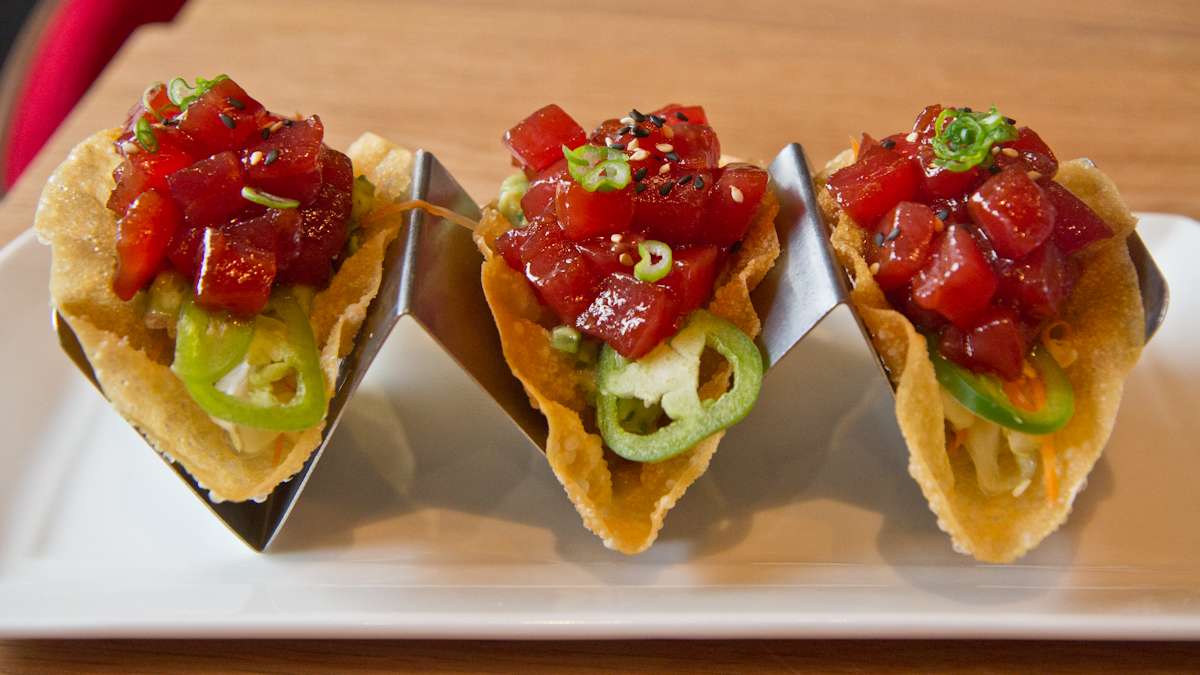
The crispy ahi tuna taco at Suga
Susanna Foo remakes childhood classics, offering a fresh take on Chinese cuisine in Philadelphia.
When Susanna Foo closed the doors to her iconic namesake restaurant after 22 years, it was amid the deteriorating health of her husband, a changing Philadelphia restaurant market, and an epically Philly altercation with a Parking Authority officer.
Over the course of nine years, Foo opened and closed a family-friendly Main Line outpost. Her husband died. The Philly food scene continued to grow. And Foo paid her debt to society through a community service cooking program with Sister Mary Scullion at Project HOME.
It was an experience she revisited for me when we spoke during the construction of SUGA, her latest — and now only — restaurant.
“That was a crazy event. But I’m really happy I worked with the homeless ladies and Sister Mary.”
Every Wednesday for three months, Foo cooked at Project HOME. At first, the women there would ask why she was there; eventually, they looked forward to her return.
“Some of them, they had a good life, they just drinking, drunking,” she said. “It was very sad.”
“Some of them even come to the kitchen to help me. Sometimes they would ask, ‘Why you always cook chicken and pork? Why don’t you do some beef and shrimp?’
“I say, OK, so I do shrimp and beef. So I became sort of friends, and they expect me every Wednesday,” she said. “It was very nice, I feel really good I did that.”
As for the Parking Authority flap?
Foo was accused of punching an officer, a charge that was eventually dropped. But not before she spent the night in a holding cell.
“Well, they changed, because of me. They’re not as vicious as they used to be.”
Fast forward to today. With the recent opening of her fifth restaurant, Susanna and her son, Gabe, are back in Center City. Just blocks from her old stomping grounds.
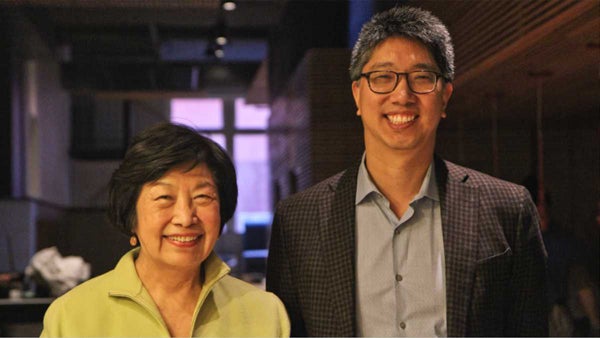 Susanna Foo and her son, Gabe Foo, pose for a photo at SUGA, while still under construction (Kimberly Paynter/WHYY)
Susanna Foo and her son, Gabe Foo, pose for a photo at SUGA, while still under construction (Kimberly Paynter/WHYY)
In its former iterations, the space now occupied by SUGA at 1720 Sansom St. was once Genji, and the Foos were close with the owners.
“We always come here, almost once a week,” Foo said. She’d bring the kids, Gabe and his brother Jim, and they’d sit at the sushi bar to eat.
“I always love this place. And I think it’s a good location and good memories,” she said. “Also Chinese talk about feng shui. The Genji was so successful, it’s a good space to have.
“I had a feng shui master take a look. And he think it’s good because it’s all open. There’s a lot of light coming in. It flows nicely.”
Foo and her team created a modern space with clean lines, lots of wood, and black lacquer, making the red upholstery pop.
During a lunch in early March, more than a few people wandered up to the window, cupping their hands at the glass to get a better look; some smiled in and continued on, others made their way through the vestibule to ask for a menu or to make a reservation.
On the day that I visited, former city district attorney and mayoral candidate Lynne Abraham sauntered in, clad in a full fur coat, to congratulate Foo on the opening and grab a seat for lunch.
The ambiance is lovely, and it sets the stage for a fresh take on the traditional Chinese food Foo and her sous chefs — Clara Park and Chris Dougherty — are preparing. The colors of the ingredients stand out against the white dishes, helped mainly by the sparing use of sauces. This allows the freshness of the vegetables to shine through.
One of the most eye-catching presentations comes in the form of a beverage. Teas are presented in clear glass pots, illuminated and kept warm by tealight candles. Tea choices such as “Wild Chrysanthemum” and “Jasmine” bloom, both in sight and flavor.
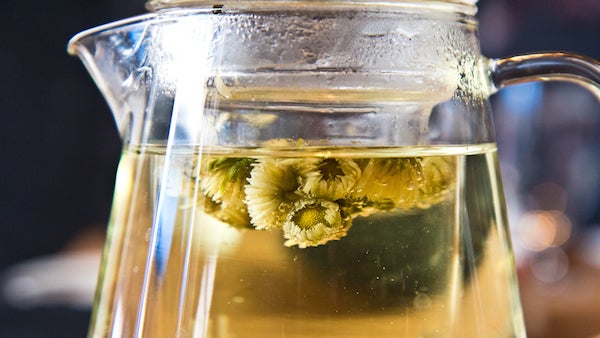 Wild Chrysanthemum tea from Yun-Nan, China (Kimberly Paynter/WHYY)
Wild Chrysanthemum tea from Yun-Nan, China (Kimberly Paynter/WHYY)
“I pick up the tea from China myself,” Foo said. “I go to China every year, sometimes twice a year,” Foo said. They harvest it in the spring, they harvest it in the fall. Two times for tea every year. And the Chinese always emphasize the fresh harvest the tea, cause that’s where the flavor is.”
Her secret to such a wonderful cup of tea?
“Most of the places here selling tea — it’s been sitting on the shelf. The Chinese always put the tea in the freezer to keep fresh.”
Fresh is an overarching theme at SUGA. Beginning with the Ahi Tuna Tacos. Translucent cubes of sushi-grade tuna are firm and splashed with just a touch of yuzu soy glaze. Served as a trio and tucked into fried wonton wrappers, the tuna sits atop a mix of jalapeño and Asian slaw, finished with a sprinkle of sesame seeds.
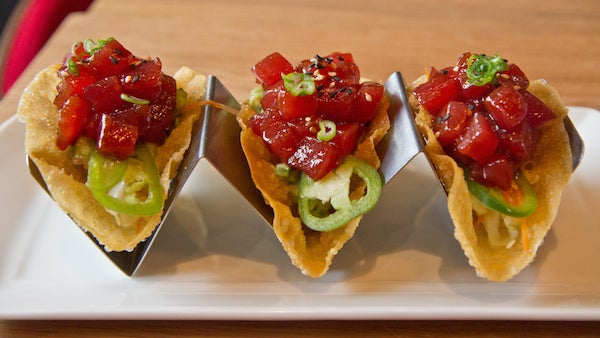 The crispy Ahi Tuna Tacos with avocado, jalapeños, and a soy glaze (Kimberly Paynter/WHYY)
The crispy Ahi Tuna Tacos with avocado, jalapeños, and a soy glaze (Kimberly Paynter/WHYY)
The jalapeño appeared in more than a few dishes; that’s not a complaint, just an observation.
I’ll mention now that aside from a brusque floor manager with evidently no interest in a scheduled press visit, the only other things I found lacking in my meal were a couple of the sauces that accompanied the dumplings. Despite its orange hue, the Spicy Carrot Sauce was neither spicy nor very carrotlike. And the Truffle Sauce was a lumpy, brownish gray.
The sampler offered a fun variety of fillings including curried chicken, vegetable, shrimp, lamb, and wild mushroom, each cooked to varying degrees of crispness. The Ginger Soy Sauce was perfectly classic and wanted for nothing.
The classic preparation supports the menu strengths.
Many dishes echo memories from Foo’s childhood, the recipes she loved back in her home province of Northern China, as well as a few tricks she’s picked up over the years.
The Liang Pan is one of those dishes.
“When you go to a Chinese restaurant, they have several cold dishes called Liang Pan, which is almost like an Italian antipasta. So we have small dishes cold. When you sit down, before you order, you can get all those little dishes, and you’re eating in the meantime as you wait for your food to come.”
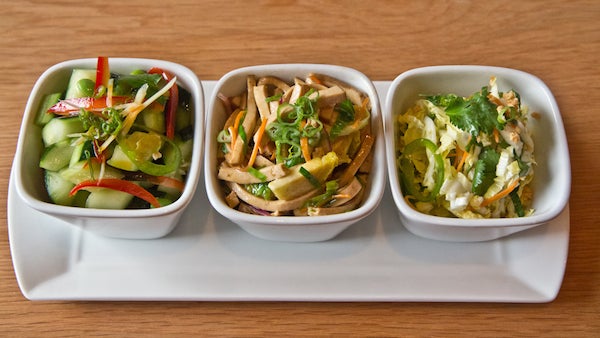 The Liang Pan with three cold salads — smashed English cucumber, smoked bean curd, and Asian coleslaw. (Kimberly Paynter/WHYY)
The Liang Pan with three cold salads — smashed English cucumber, smoked bean curd, and Asian coleslaw. (Kimberly Paynter/WHYY)
It was served as a trio: Asian coleslaw; smoked bean curd and Brussels sprouts; and English cucumbers. Each was more lovely and fresh than the last, all healthy and lightly sauced. Even our photographer, Kimberly Paynter indulged. She is a vegetarian and has celiac disease.
“Cucumber is always popular, so we do a smashed cucumber with edamame,” said Foo. “We do Asian cole slaw; we use Napa cabbage julienned, which is very traditional, with coriander, crushed roasted peanuts, jalapeño pepper and then roasted sesame dressing. Very refreshing.
And the smoked bean curd, “which was very popular for Chinese.”
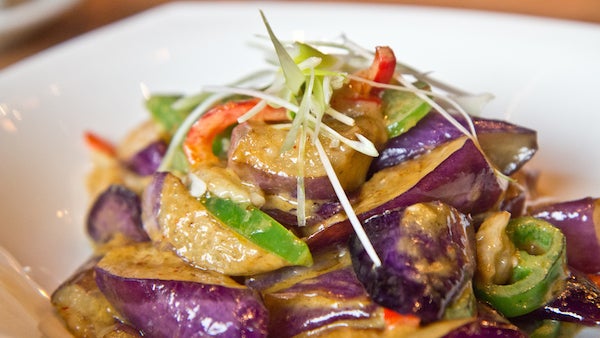 Chinese eggplant with shishito pepper and Thai curry (Kimberly Paynter/WHYY)
Chinese eggplant with shishito pepper and Thai curry (Kimberly Paynter/WHYY)
The Chinese eggplant was exciting, both visually and texturally, with it’s bright purple hues and mix of soft eggplant and firm peppers tossed in a Thai curry.
The Spicy Shanxi Cat Ear Pasta with Jamison Farm Lamb Ragu was one of my favorite dishes. As an Italian-American, I enjoyed the cultural crossover. The little orecchiette pasta, brought in from Severino Pasta Company in New Jersey was tossed with tiny cubes of potato, tomato, and lamb; each was cooked perfectly and mixed together at just the right time.
“That’s the original name, we call it ‘cat ears.’ It’s a direct translation,” Foo said. “The region where my family comes from — my origin is from Inner Mongolia — we eat a lot of lamb. The lamb is sort of smaller, it’s really good. I thought the lamb from my region is the best.”
As it sometimes happens, certain dishes are better the second day, which is what I found with the Kung Pow Chicken. The ingredients were fresh and it was well prepared, but it didn’t have enough time to really come together — at least at first. The cubed, marinated chicken, button mushrooms, red peppers, snap and snow peas, roasted peanut and Kung Pow sauce needed time to meld.
And while I wasn’t fully sold initially, I did enjoy it the next day.
SUGA absolutely has a place in this city’s dining scene. If nostalgia, fresh, well-prepared ingredients, and Chinese leftovers aren’t a draw, I don’t know what is.
WHYY is your source for fact-based, in-depth journalism and information. As a nonprofit organization, we rely on financial support from readers like you. Please give today.




